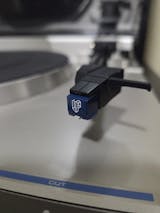Parts of a Turntable
Posted by LP Tunes on
Platter and Plinth
The main body of a turntable is called a plinth. It’s the rectangular box that holds all the parts together. The flat, round, spinning counterpart on top of it is called the platter. The platter, just like at Thanksgiving dinner, is the plate that serves up the main course—the music. This is the part that therecord sits on. A spindlepokes up through the center of it, which is the piece that fits through the center hole of records.
The platter is spun by a motor that hides inside the plinth. A direct-drive motorsits directly under the spindle, whereas a belt-drive motorsits off to the side of it and pulls the platter along via a rubber belt. The top of the platter is clothed in a soft matthat not only reduces vibrations from the motor, but also keeps the vinyl from being scratched by the platter’s hard surface.
Stylus, Cartridge, and Tonearm
Also called the needle, the stylus is the small, often diamond-tipped piece that runs along the grooves of records. Different kinds of styluses can be used depending on what kind of record is being played. It is a very common misconception that you can use any stylus to play on any record. Styli made for LP records are much narrower and will sway on either side of the groove wall causing damage to the record, the stylus, and potentially your ears!
The stylus is connected to the tonearm(the metal rod that holds the stylus in place on the record) via a box called the cartridge, which absorbs the vibrations picked up by the stylus and translates them into music. Since the phono cartridge is responsible for receiving and sending the input from the record, it controls much of how your entire turntable system will sound. An audio system sounds as good as it’s cartridge and no better.That is why it is important to change your stylus once a year or after 500 hours of play.
The piece of the tonearm that connects to the cartridge is called the headshell, and it plugs into the cartridge with four, color-coded, lead wires. The electrical signal flows through the inside of the tonearm to the counterweighton the opposite end. The counterweight is a dial that not only balances the tonearm and controls the tracking force, it also keeps the needle from being too lightwhere it can skip and scratch the vinyl, or from being so heavy it will grind into the record’s grooves.
Beside the counterweight knob is the anti-skate adjustment knob which also prevents the needle from skipping, since it is pulled toward the spindle,(the way a ship would be drawn toward the center of a whirlpool) and the height adjust which keeps the tonearm parallel with the record so that the stylus sits in the groove properly.
Dust Cover
A record’s greatest enemy is dust, which can gum up the grooves, cause scratches in the vinyl, and lower the overall quality of sound. Most turntables come with a dust cover, which is a sort of lid that closes over the entire device. Typically records can still be played with the dust cover closedand the music will still play crisp and clean.



